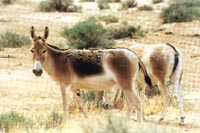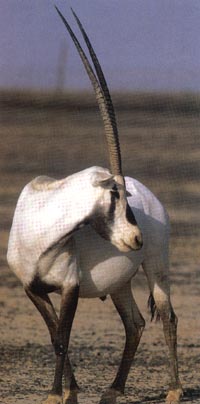The Oryx can often be seen roaming freely in the desert grassland, and the Ostriches, Gazelles and Onagers can be observed in their enclosures. Shaumari's breeding enclosures provide a small "zoo" for visitors, making the reserve a popular spot for children and school outings.
Wild Life
The Shaumari area once contained an abundance of large animals, including Gazelles, Oryx, Onager, Ostrich, Cheetah, Hyena and Wolf. While most of these animals have disappeared from Shaumari altogether, some are now a part of the pioneering wildlife reintroduction program.
Visitor's Center
Shaumari's visitors' center contains a small museum holding interactive materials, slide shows, and videos on the history and wildlife on the Reserve. A playground and picnic area is located on the outside premises of the center.
Observation Tower
The observation tower provides eager animal watchers with a perfect location for spotting the Reserve's wild life. The early hours of the morning are in particular the best for observing the Oryx in its natural environment.
The
Oryx Story
The Oryx, an elegant white antelope, is one of
the few mammals indigenous to the Arabian Peninsula. It became extinct in
Jordan around the 1920s, as a result of the increased hunting for its
meat, coat and horns. The increasing range and power of rifles compounded
by the factor of motorized vehicles were the key to the extinction of the
Oryx. The last known wild Oryx in the world was killed by hunters in Oman
1972.
Fortunately, previous to the unodent, in 1962, the
Flora and Fauna Preservation Society and the World Wildlife Fund had
launched an international rescue effort known as Operation Oryx. A world
survival herd was established in the USA, with three animals from Oman,
one from the London zoo, one from Kuwait, and four from Saudi
Arabia. This herd increased steadily in numbers, and the Royal Society for
the Conservation of Nature proposed that the Oryx should be reintroduced
into its native habitat in the Arabian Desert.
In 1978, eleven Oryx were relocated in Shaumari. The
number of Oryx has now increased to a phenomenal two hundred! Operation
Oryx has been so successful that Jordan now supplies Oryx to other
countries which are conducting reintroduction programs.





(JERASH - DECAPOLIS ERA - JORDAN - PETRA - WADI RUM - AQABA - THE DEAD SEA - MUJIB WILDLIFE RESERVE - DANA NATURE RESERVE - SHAUMARI NATURE RESERVE - AJLOUN NATURE RESERVE - AZRAQ WETLAND RESERVE - BIRD WATCHING - THE GULF OF AQABA - BETHANY BEYOND JORDAN)
EGYPT - LEBANON - SYRIA